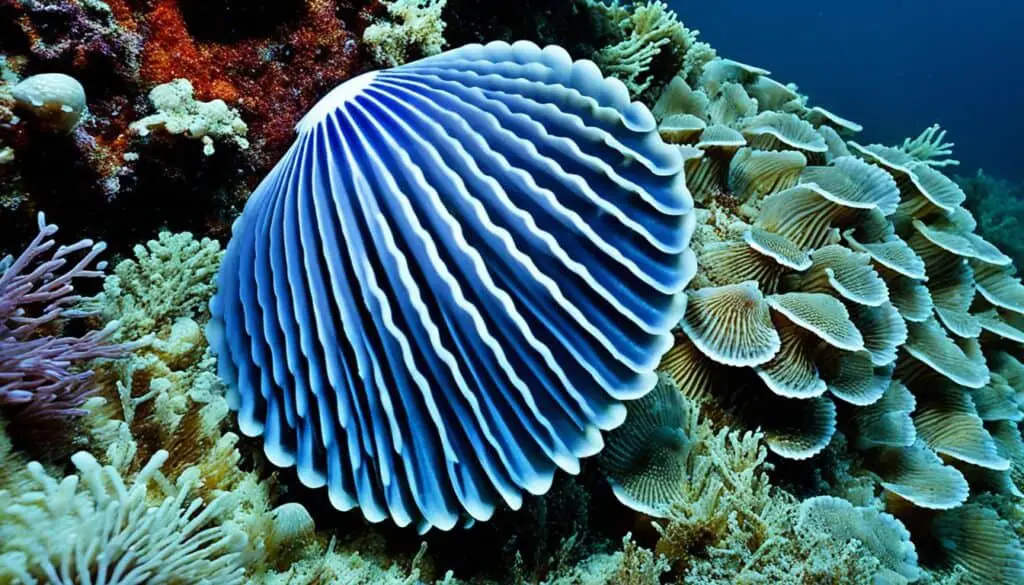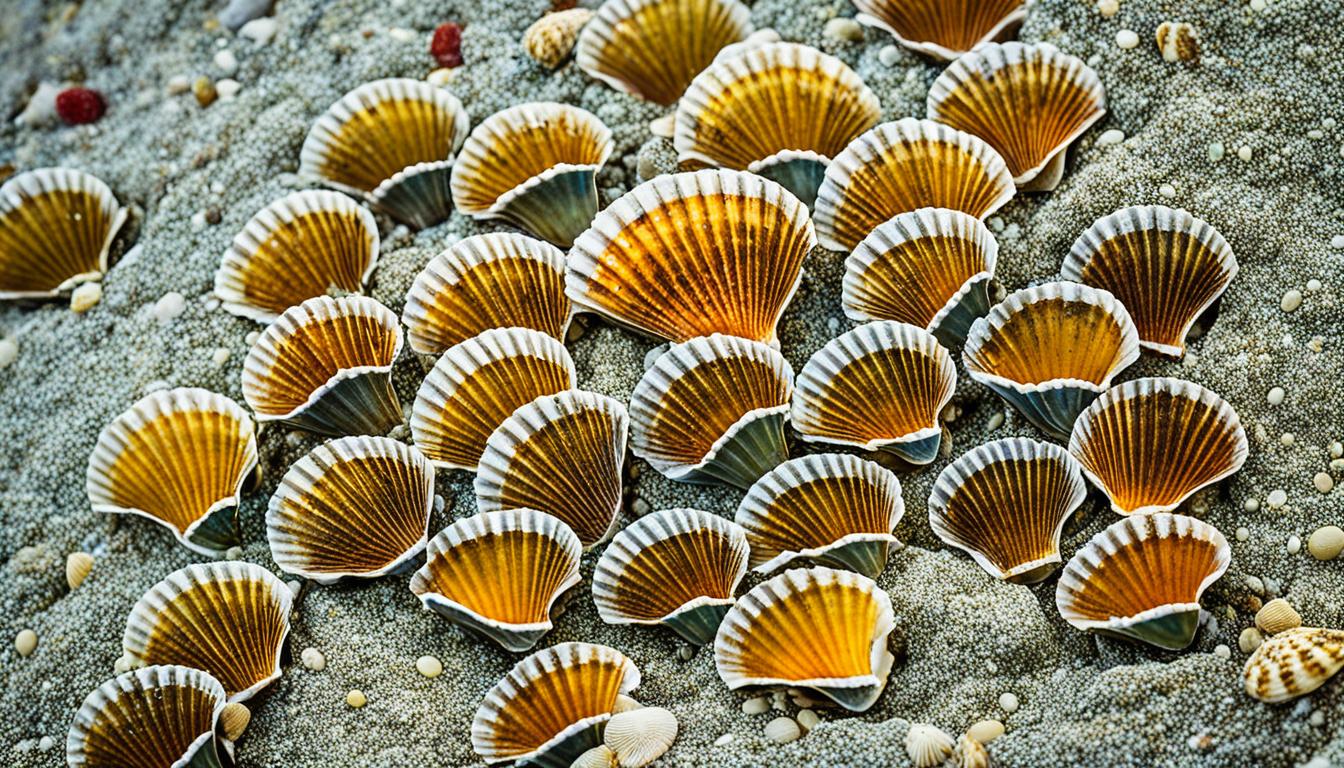Scallops are fascinating creatures in the ocean, part of the Mollusca phylum and Bivalvia class. They have evolved ways to protect themselves from predators. These methods include defense mechanisms and behaviors crucial for survival. Their anatomy and physiology play a big part in avoiding predators.
Let’s dive into how scallops protect themselves and their survival tactics. You’ll learn about their strategies to stay safe in the ocean.
Understanding Scallop Anatomy
To truly appreciate scallops, you must delve into their unique scallop anatomy. This exploration reveals the fascinating physical structure and the remarkable shell characteristics that define these creatures. Scallops are bivalve mollusks, where their two-part shells are essential for protection and adaptation within their marine environments.
Physical Structure of Scallops
The physical structure of scallops includes a distinct arrangement of features. They possess a two-part shell: the upper valve is often dark and mottled, granting camouflage against ocean substrates. The lower shell contrasts with a lighter hue, frequently appearing white. Some scallops display vibrant colors like yellow or orange, although such variations are uncommon. Typically, scallops can grow to a height of approximately 75-90 mm and may live for up to two years in optimal conditions. Their diet consists mainly of algae and organic particles filtered from the surrounding water.
Shell Characteristics and Variations
Scallop shell characteristics vary significantly among species. Generally, you will notice several key traits:
- Shape: The shells are fan-shaped, allowing easy movement in the water.
- Color Patterns: These can range from muted earthy tones to rare bright shades.
- Size: Size can vary based on environmental conditions, with some individuals reaching impressive dimensions.
As you examine scallops, the intricate details of their shells reveal a lot about their habitat and survival strategies. The physical structure and shell characteristics are vital not only for protection but also for interaction with their environment.
| Characteristic | Description |
|---|---|
| Shell Shape | Fan-shaped, enabling agile movement |
| Upper Valve Color | Dark and mottled for camouflage |
| Lower Valve Color | Lighter, often white |
| Size | Typically 75-90 mm in height |
| Diet | Primarily algae and organic particles |
How do scallops protect themselves?
Scallops have amazing ways to stay safe in the ocean. They use both physical and behavioral tricks to avoid predators. Their shells and how they move are key to their survival.
Defense Mechanisms Explained
Scallops have many ways to defend themselves. When they feel danger, they quickly shut their shells. This keeps their soft body safe from predators and harm.
They also have strong muscles that let them swim fast away from danger. This quick escape helps them avoid being caught.
The Role of Shells in Protection
The scallop shell is a big part of their defense. It acts as a shield against predators and helps them blend in. The shell’s colors and patterns make it hard for predators to spot them.
When scallops close their shells, they also protect their gills from harmful stuff like silt. This shows how important their shells are for staying safe.

Scallop Defense Mechanisms
Scallops have many ways to avoid being eaten, using both their body shape and muscle power. These strategies help scallops stay safe in the water.
Closing Shells to Avoid Predation
One key way scallops stay safe is by quickly closing their shells. This protects their insides from harm. When they sense danger, they shut their shells tight to keep predators out.
This action not only stops predators from getting to them but also keeps them safe in the water.
Using Adductor Muscles for Quick Escape
Scallops are also very agile thanks to their muscles. The adductor muscles are key here. They let scallops move fast away from danger.
By quickly contracting and relaxing these muscles, scallops can swim away quickly. This helps them avoid many predators, using both their body and behavior to stay alive.
Scallop Predator Avoidance Strategies
Scallops have developed smart ways to avoid predators and thrive in their homes. They use special senses to spot threats and react fast. Their tiny, blue eyes sit along the shell’s edges. These eyes help them watch for predators nearby.
Detection of Predators Using Eyes
Scallops can see changes in light and movement with their remarkable eyes. This alerts them to predators. It’s like having an early warning system. When they see a threat, they know what to do next.
Behavioral Responses to Threats
When scallops sense danger, they act fast to stay safe. They might close their shells or swim away. These quick moves help them avoid predators and keep their numbers up. By learning about scallop defense, we see how they’ve adapted to stay safe in the water.
FAQ
How do scallops protect themselves from predators?
Scallops use both physical and behavioral ways to stay safe from predators. They quickly shut their shells with strong muscles and swim fast to get away.
What are the primary defense mechanisms of scallops?
Scallops mainly protect themselves by closing their shells tightly and swimming away quickly. Their strong muscles help them move fast to escape danger.
How does the shell function in scallop protection?
The scallop shell is a key defense tool. It protects them from predators and helps them blend in with their surroundings. This makes it harder for predators to find them.
How do scallops detect potential predators?
Scallops have small blue eyes along their shell’s rim. These eyes help them see movement and threats. This helps them avoid predators.
What behavioral responses do scallops exhibit when threatened?
When threatened, scallops close their shells fast and swim away quickly. They push water out to move quickly and avoid predators.







